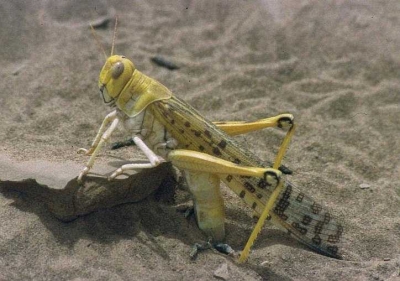
- The desert locust is potentially the most dangerous of the locusts because of the ability of swarms to fly rapidly across great distances. Plagues of the desert locust have threatened agricultural production in Africa, the Middle East and Asia for centuries.
- During quiet periods (known as recessions) the desert locust is usually restricted to the semi-arid and arid deserts of Africa, the Near East and South-West Asia, inhabiting some 30 countries (including India) but during plagues, they may spread over an enormous area of nearly 30 million sq. km., extending over 60 countries.
- According to the National Geographic, a single swarm of the desert locust can be 460 square miles in size and pack between 40 and 80 million individuals into less than half-a-square mile. Each locust can eat its weight in plants each day, so a swarm of such size would eat 423 million pounds of plants every day.
- The desert locust flies with the wind and swarms can travel from about five to 130 km or more in a day. Solitary adults usually fly at night whereas gregarious adults fly during the day. The locust can live between three and six months, and there is a 10- to 16-fold increase in locust numbers from one generation to the next.
When conditions are right
- The desert locust reproduces and increases in numbers, when conditions are favourable. It needs moist, sandy soil to lay eggs and fresh vegetation for hoppers (nymphs) to grow into adults. A good monsoon is therefore a cause for concern.
- Females lay about 95 to 158 eggs in an egg pod in soft soils at a depth of 10 to 15 cm below the surface. The location needs to be at the night temperature and right degree of dampness.
- Thought it’s still a mystery what triggers solitary insects to become gregarious, scientists have theorised that a primary cause of the switch happens when individuals regularly touch others on the hind legs within populations. When population starts to build up following a period of drought, individuals concentrate in an environment while foraging. As young insects get more crowded, the close physical contact causes the insects’ hind legs to bump against one another. This triggers a change in behaviour, they say.
Picture Credit : Google
